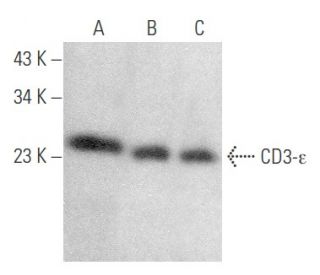
Click on image or enlarge button to enlarge
CD3-ε Antibody (UCH-T1): sc-1179
- CD3-ε Antibody (UCH-T1) is a mouse monoclonal IgG1 κ CD3-ε antibody, cited in 29 publications, provided at 200 µg/ml
- raised against human infant thymocytes and lymphocytes from a patient with Sezary Syndrome
- CD3-epsilon Antibody (UCH-T1) is recommended for detection of CD3-ε of human origin by WB, IP, IF, IHC(P) and FCM
- Anti-CD3-epsilon Antibody (UCH-T1) is available conjugated to agarose for IP; HRP for WB, IHC(P) and ELISA; and to either phycoerythrin or FITC for IF, IHC(P) and FCM
- also available conjugated to Alexa Fluor® 488, Alexa Fluor® 546, Alexa Fluor® 594 or Alexa Fluor® 647 for WB (RGB), IF, IHC(P) and FCM, and for use with RGB fluorescent imaging systems, such as iBright™ FL1000, FluorChem™, Typhoon, Azure and other comparable systems
- also available conjugated to Alexa Fluor® 680 or Alexa Fluor® 790 for WB (NIR), IF and FCM; for use with Near-Infrared (NIR) detection systems, such as LI-COR®Odyssey®, iBright™ FL1000, FluorChem™, Typhoon, Azure and other comparable systems
- also available conjugated to Alexa Fluor® 405 for IF, IHC(P) and FCM
- Contact our Technical Service Department (or your local Distributor) for more information on how to receive a FREE 10 µg sample of CD3-ε (UCH-T1): sc-1179.
- m-IgG Fc BP-HRP and m-IgG1 BP-HRP are the preferred secondary detection reagents for CD3-ε Antibody (UCH-T1) for WB and IHC(P) applications. These reagents are now offered in bundles with CD3-ε Antibody (UCH-T1) (see ordering information below).
QUICK LINKS

CD3-ε Antibody (UCH-T1) is an IgG1 κ mouse monoclonal CD3-epsilon antibody (also designated CD3 antigen epsilon polypeptide antibody, CD3E antibody, or CD3 epsilon antibody) that detects the CD3-epsilon protein of human origin by WB, IP, IF, IHC(P) and FCM. CD3-ε Antibody (UCH-T1) is available as both the non-conjugated anti-CD3-epsilon antibody form, as well as multiple conjugated forms of anti-CD3-epsilon antibody, including agarose, HRP, PE, FITC and multiple Alexa Fluor® conjugates. The T cell antigen receptor (TCR) recognizes foreign antigens and translates such recognition events into intracellular signals that elicit a change in the cell from a dormant to an activated state. Much of this signaling process can be attributed to a multisubunit complex of proteins that associates directly with the TCR. This complex has been designated CD3 (cluster of differentiation 3). It is composed of five invariant polypeptide chains that associate to form three dimers: a heterodimer of gamma and epsilon chains (CD3-γ and CD3-ε), a heterodimer of delta and epsilon chains (CD3-δ and CD3-ε) and a homodimer of two zeta chains (CD3-ζ) or a heterodimer of zeta and eta chains (CD3-ζ and CD3-η). CD3-ζ and CD3-η are encoded by the same gene, but differ in their carboxyl-terminal ends due to an alternative splicing event. CD3-γ, CD3-ε and CD3-δ each contain a single copy of a conserved immunoreceptor tyrosine-based activation motif (ITAM). In contrast, CD3-ζ contains three consecutive copies of the same motif. Phosphorylated ITAMs act as docking sites for protein kinases such as ZAP-70 and Syk and are also capable of regulating their kinase activity. The crystal structure of the ZAP-70 SH2 domains bound to CD3-ζ ITAMs has been solved.
Alexa Fluor® is a trademark of Molecular Probes Inc., OR., USA
LI-COR® and Odyssey® are registered trademarks of LI-COR Biosciences
References:
- Structure, assembly and intracellular transport of the T cell receptor for antigen. | Exley, M., et al. 1991. Semin Immunol. 3: 283-97. PMID: 1686832
- Signal transduction by the T cell antigen receptor. | Weiss, A., et al. 1991. Semin Immunol. 3: 313-24. PMID: 1839225
- Signal transduction. Zapping tandem SH2 domains. | Weiss, A. 1995. Nature. 377: 17-8. PMID: 7659151
- Molecular basis for interaction of the protein tyrosine kinase ZAP-70 with the T-cell receptor. | Hatada, MH., et al. 1995. Nature. 377: 32-8. PMID: 7659156
- Binding of ZAP-70 to phosphorylated T-cell receptor zeta and eta enhances its autophosphorylation and generates specific binding sites for SH2 domain-containing proteins. | Neumeister, EN., et al. 1995. Mol Cell Biol. 15: 3171-8. PMID: 7760813
- Different cytoplasmic structure of the CD3 zeta family dimer modulates the activation signal and function of T cells. | Aoe, T., et al. 1994. Int Immunol. 6: 1671-9. PMID: 7865460
- The role of protein tyrosine kinases and protein tyrosine phosphatases in T cell antigen receptor signal transduction. | Chan, AC., et al. 1994. Annu Rev Immunol. 12: 555-92. PMID: 8011291
- Targeted disruption of the CD3 eta locus causes high lethality in mice: modulation of Oct-1 transcription on the opposite strand. | Ohno, H., et al. 1994. EMBO J. 13: 1157-65. PMID: 8131747